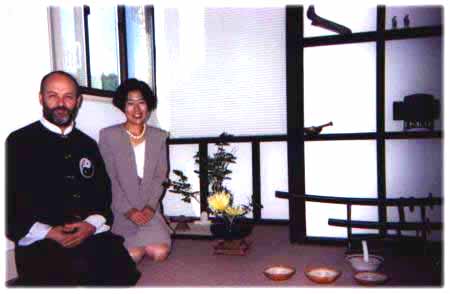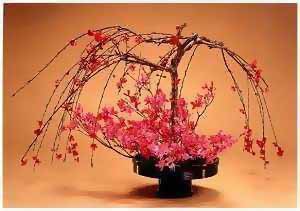|
Sogetsu Ikebana
The Ikebana classes are held once or twice a
month. The students are guided step by step
through the Sogetsu school program; each level
is supported by a printed curriculum,
originally from Japan, which illustrates the
assignments in a progressive development, from
the very simple to more complex floral
arrangements. After one book is studied and
well understood, the student obtains a
Diploma, issued directly from the Sogetsu
Headquarters in Tokyo, signed by the head
master. There are four books for amateurs.
After that student can continue to study for
the teaching license recognized by the same
forum. Included in the price are the plant
materials. These are provided by the
Institute. The tools are the student's
responsibility; we assist in getting them. It
is greatly relaxing to be able to express
balance, harmony, beauty and tranquility using
flowers, water and containers. It is another
expression of self-discovery in our Mind-Body
journey.

Master Chinda and Reiko Nakajima, our
Ikebana Instructor at the
Chinda Institute
History of Ikebana
Of all Japan's traditional arts, perhaps the
most famed and actively practiced today is
IKEBANA, the art of flower arrangement. While
tracing its origins back for hundreds of
years, it still exists as a vital element in
the contemporary world of art. It has emerged
from its historical setting within the
"tokonoma" alcove of the Japanese house and
entered the modern everyday world: the office
window or the conference room, the hotel lobby
or public square. In the same way, Ikebana is
no longer the exclusive province of arrangers
or artists in Japan, but counts among its
devotees professional and amateur designers in
all nations and walks of life.
With this added dimension to the use and
meaning of Ikebana, the fundamentals of
structure, space and naturalism, which have
been developed and perfected over the
centuries, have remained the same.
In basic form, an Ikebana arrangement
follows a fixed pattern: a triangle of three
points representing Heaven, Earth and Man.
Emphasis is placed on linear perfection, color
harmony, space and form. If commonplace branch
material is arranged in a beautifully flowing
line, it takes preference over a mass of
blooms or blossoms, regardless of their
beauty. Of equal importance is the sense of
naturalism: an arrangement encompasses nature
in all its aspects - from the tall stately
pine to the lowliest blade of grass. Further,
an Ikebana usually contains the foliage and
flowers of the season at hand, used in their
natural state except for the deft "cut" of the
arranger's clippers which perfects the line of
a branch or the shape of a bud.
There are numerous schools of Ikebana, each
following a particular set of rules and
arranging techniques, but without losing sight
of the fundamentals of the art. And in keeping
with the broader emphasis being given to
Ikebana in its role in contemporary living,
many of the schools seek expression in forms
that reach beyond traditional styles.
|






